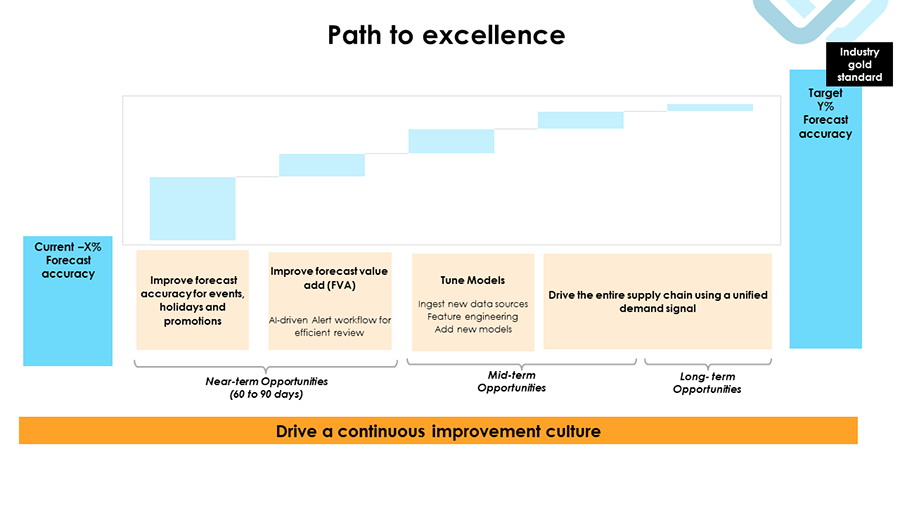
We know that for many retailers and CPG companies, AI/ML solutions represent a game-changing technology. Yet, this journey seldom comes without a few expectable “growing pains”—from adoption and scale through a fully-fledged data-driven transformation. For multiple internal stakeholders across an organization, the end-to-end process can seem quite daunting—especially without a well-defined plan.
Our first priority for every new customer is to help facilitate an efficient transition—enabling them to quickly ramp up benefits from leading-edge data science while sidestepping potential early roadblocks. After taking time to look back on lessons learned from our previous customer successes, we’ve outlined a comprehensive 10-step roadmap which we can recommend to any retailer or CPG as they integrate our AI-powered demand intelligence solutions:
- Establish the “North Star”. At the outset of an AI rollout, agree upon an overarching goal—the organization’s central vision—and lay the groundwork for sustaining an efficient, conflict-free organizational alignment.
- Create a change management team. A dedicated internal team should be formed around a pragmatic approach that anticipates looming roadblocks, identifies and empowers the organization’s most vital super-users, and provides comprehensive training with ongoing subject matter expert (SME) support as needed.
- Assemble a multidisciplinary team. A separate implementation team brings the technical expertise and experience necessary to successfully execute AI programs. To tackle the problem holistically, a multidisciplinary team made up of people with domain, analytics, and technology experience is essential.
- Conduct EDA. Designing and performing a formal Exploratory Data Analysis (EDA) is a key data assessment of existing quality and coverage, pinpointing gaps or bottlenecks and developing effective mitigation plans upfront.
- Credibility, then trust. Credibility and legitimacy of an AI initiative among the user community should be established at the outset, while trust should be built along the journey.
- Crawl, walk, and run. A predetermined ramp-up timeline is very helpful to first identify champions/super users, design, deploy and evaluate one or more pilots, access overall value, then ultimately achieve optimal scale.
- Manage scope with strict guidelines. Maintaining an end-to-end operational context is crucial toward identifying core requirements versus peripheral "edge cases" and avoiding distractions.
- Create a process and technology integration map. A single-source integration blueprint document, approved by senior management, provides single-source clarity to stakeholders of upstream and downstream processes.
- Outline a roadmap/Path to Excellence. Marking additional long-term goals—encompassing as much as a two-year timeframe—includes outlining ideas and experiments to be conducted—affirms original objectives and can often help reinforce a continuous improvement culture, as we can illustrate below:

- Celebrate success and people. Don’t forget to acknowledge incremental improvements as well as major milestones, along with the people—teams, and individuals—who make them happen. Positive feedback is essential for promoting healthy team morale and an overall conducive company culture.
These points represent a broad framework, and there’s plenty to elaborate on. Look for a more detailed roadmap later this year, as we add it to the other useful resources in our downloadable Research & eBooks library. In the meantime, feel free to contact us with any questions regarding the benefits of AI-powered solutions and their successful implementation.

